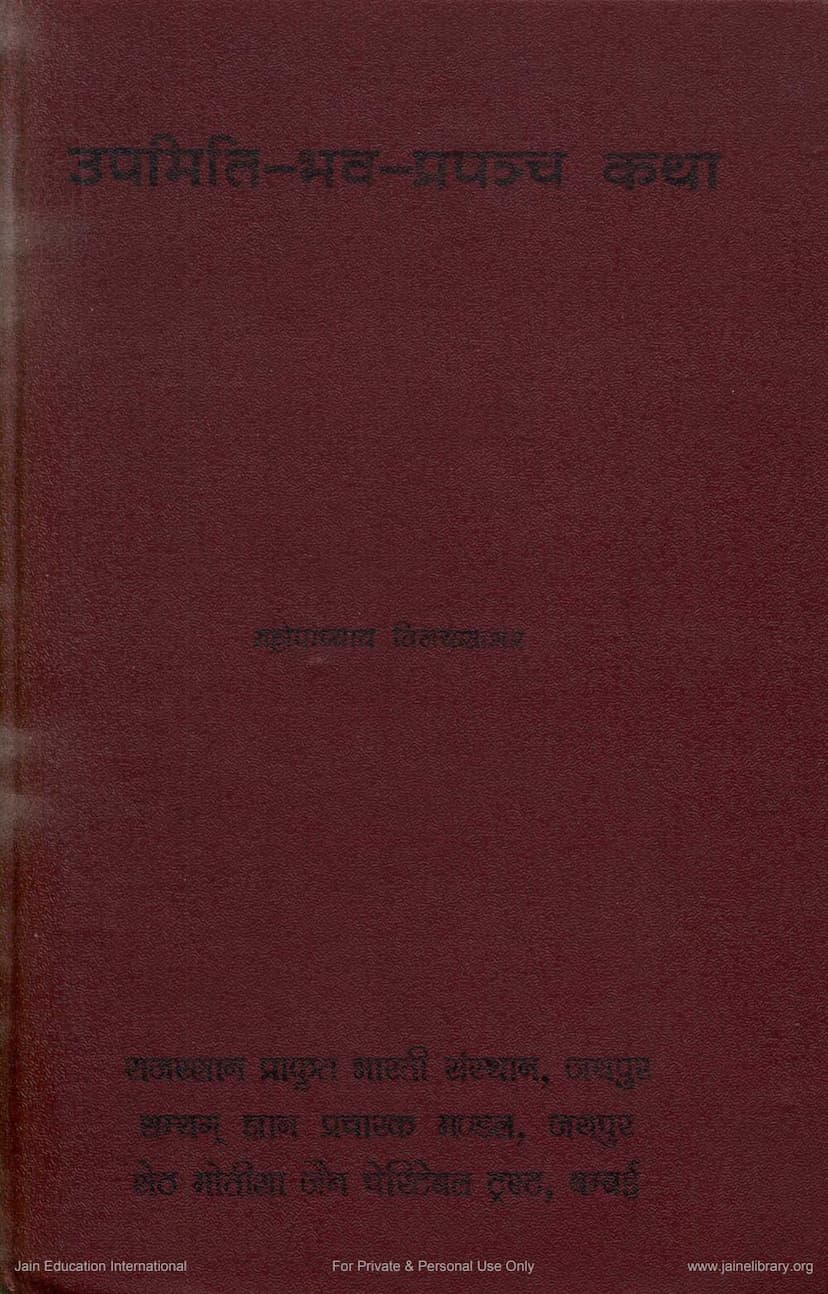Upmiti Bhav Prakasha Katha Part 1 And 2
Added to library: September 2, 2025

Summary
This is a comprehensive summary of the Jain text "Upmiti Bhav Prakasha Katha Part 1 and 2" based on the provided text, focusing on the essence and key aspects presented in the introductory and first proposition sections.
Book Title: Upmiti Bhav Prakasha Katha Part 1 and 2 Author(s): Siddharshi Gani, Vinaysagar Publisher: Rajasthan Prakrit Bharti Sansthan Jaipur
Overview:
"Upmiti Bhav Prakasha Katha" (The Story of the Elucidation of the Cycle of Existence) is a significant work in Jain literature, composed in Sanskrit by the esteemed scholar Siddharshi Gani in the 10th century. It is renowned for being a remarkably extensive allegorical text, possibly unparalleled in its scale. The work delves into various facets of human life and Dharma (righteousness/duty) through the lens of metaphors and similes, presenting psychological and engaging insights, a testament to the author's multi-faceted personality and profound experiences.
Author's Background (Siddharshi Gani):
Siddharshi Gani was originally a householder with a life heavily influenced by worldly attachments. A pivotal moment occurred when, after hearing reproaches from his mother and wife, he left home in anger. Under the guidance of the prominent Jain scholar Shraman Durgaswami, he embraced Jain monasticism. He then engaged in extensive comparative studies of various religions and philosophies, even being drawn to Buddhism and becoming a Buddhist Shraman for a period. However, true to a promise made to his original guru, he returned, attained renewed enlightenment, and reaffirmed his commitment to Jain monasticism. It is this rich life experience of embracing and renouncing different paths that enabled him to create such a profound work.
Literary Significance:
The text is highly regarded for its unique style and its presentation of Dharma on a universal human level, moving beyond limited religious boundaries. The author masterfully uses allegories and similes to convey profound psychological and spiritual truths. Scholar Hermann Jacobi was so impressed by the work that he declared it a unique and original contribution to Indian Sanskrit literature. The original Sanskrit text has been edited and published, and translations into German and Gujarati have also been made. Prominent Hindi scholars have also translated parts of the text, though a complete Hindi translation was a long-awaited endeavor.
The Narrative Structure and Core Message:
The Upmiti Bhav Prakasha Katha is structured as an elaborate allegory. The author, Siddharshi Gani, introduces himself in the first proposition as Nishpunyak, a miserable, impoverished, and afflicted mendicant burdened by various ailments, entangled in the webs of doubt and indecision. This mendicant, through the grace of benevolent spiritual guides (Acharyas) and by consuming the "elixir of pure knowledge" and "nectar of truth," attains purity and eventually becomes a part of the enlightened community (Sangh). The narrative then follows this transformed soul (Sipunyak) as Siddharshi, who, through the medium of this story, aims to propagate the virtues of the "three jewels" (Ratnatraya: Right Faith, Right Knowledge, Right Conduct).
The entire work is grounded in psychology. The events and situations described are not mere fabrications but are presented as authentic reflections of the journey of the soul (Jiva/Atma) through the cycle of existence (Samsara). The narrative highlights the struggles of a soul ensnared by passions like anger, greed, delusion, and the senses, leading to various births and sufferings. The author emphasizes that the soul itself is inherently pure and blameless; the afflictions arise from the influence of "Moharaj" (King Delusion) and his cohorts (kashayas like anger, pride, deceit, greed, and the senses). The ultimate message is the renunciation of these vices to attain liberation.
Key Themes and Teachings:
- Allegory: The text extensively uses allegories to represent abstract spiritual concepts and the soul's journey.
- Psychology of Attachment: It details the internal struggles of the soul caught in worldly desires, passions, and the cycle of birth and death.
- Path to Liberation: The story illustrates the process of spiritual awakening, from initial misery (Nishpunyak) through purification and enlightenment, culminating in the soul's union with the ultimate reality (Sipunikya/Siddharshi).
- The Role of Knowledge and Guidance: The importance of spiritual teachers (gurus) and the "three jewels" (Ratnatraya) is underscored as essential for overcoming worldly bonds.
- Universality of Dharma: The teachings transcend specific religious dogma, focusing on universal human virtues and the path to inner peace and liberation.
- Critique of Vices: The text graphically portrays the detrimental effects of vices like attachment, anger, greed, and ignorance on the soul's journey.
The Hindi Translation and its Context:
The provided text is the first complete Hindi translation of "Upmiti Bhav-Prapancha Katha." The publication was a collaborative effort by multiple Jain institutions, highlighting the importance placed on making this profound work accessible to the Hindi-speaking audience. The preface by Devendraraj Mehta and others emphasizes the historical and literary value of the work, the author's unique journey, and the meticulous effort involved in its translation and publication. The detailed introduction by Devendramuni Shastri provides a rich context of Indian philosophical and literary traditions, the evolution of Sanskrit language, and the place of Upmiti Bhav-Prapancha Katha within the broader tapestry of Indian narrative literature, including its unique contribution to allegorical literature.
In essence, "Upmiti Bhav Prakasha Katha" is a philosophical and psychological narrative that uses a profound allegorical framework to guide the reader through the complexities of existence, the pitfalls of attachment and ignorance, and the ultimate path to spiritual liberation, all stemming from the rich life and scholarly depth of Siddharshi Gani.